
CanAlaska Intersects Ultra High-Grade Unconformity Uranium Mineralization 100 Metres West at Pike Zone
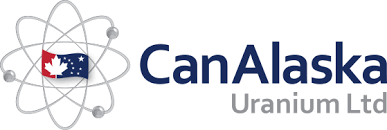
Unconformity-Hosted Uranium Consists of 3.88% eU3O8 over 13.2 metres, Including 23.22% eU3O8 over 2.0 Metres
Summer Drill Program Complete with Multiple Ultra High-Grade Uranium Intersections; Assays Pending
CanAlaska Uranium Ltd. (TSX-V: CVV) (OTCQX: CVVUF) (FSE: DH7) is pleased to provide an update on the summer diamond drill program at the Pike Zone on the West McArthur Joint Venture project in the eastern Athabasca Basin. Multiple drillholes have confirmed high-grade mineralization, highlighted by WMA094-2 which intersected 3.88% eU3O8 over 13.2 metres, including 23.22% eU3O8 over 2.0 metres and WMA094-1 which intersected 3.41% eU3O8 over 9.9 metres, including 8.08% eU3O8 over 3.7 metres on expansion drilling to the west. These new drillholes expand the high-grade footprint at Pike Zone over 100 metres at the unconformity and indicate the potential for significant additional zones of ultra high-grade uranium mineralization to the west of the Pike Zone where the trend remains open along strike. The West McArthur project, a Joint Venture with Cameco Corporation, is operated by CanAlaska that holds an 83.35% ownership in the Project (Figure 1). CanAlaska is sole-funding the 2024 West McArthur program, further increasing its majority ownership in the Project.
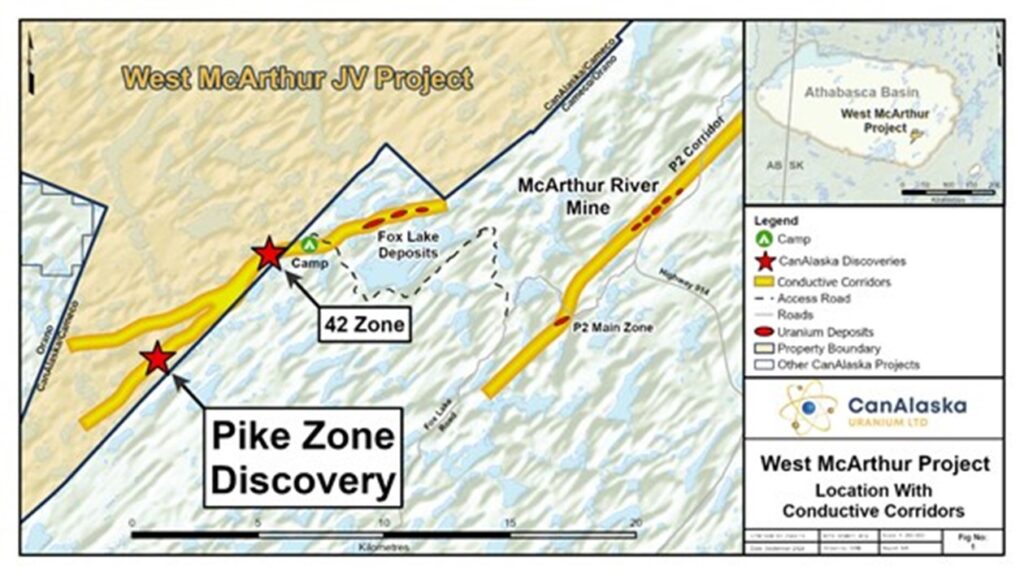
Figure 1 – West McArthur Project Location
CanAlaska CEO, Cory Belyk, comments, “The intersection of ultra high-grade uranium 100 metres west of the main pod at Pike Zone is exactly what the team was hoping to achieve as part of the summer drilling program. Tier 1 Athabasca Basin uranium deposits commonly occur as high-grade ‘pearls on a string’ and this is what we are seeing develop at the Pike Zone. The importance of this new ultra high-grade uranium discovery to CanAlaska, our shareholders, and the Joint Venture cannot be understated. With drilling now complete and with nearly $12 million in CanAlaska’s treasury, the team is now focused on developing the 2025 exploration program and budget with our partner to follow-up these incredible drilling results.”
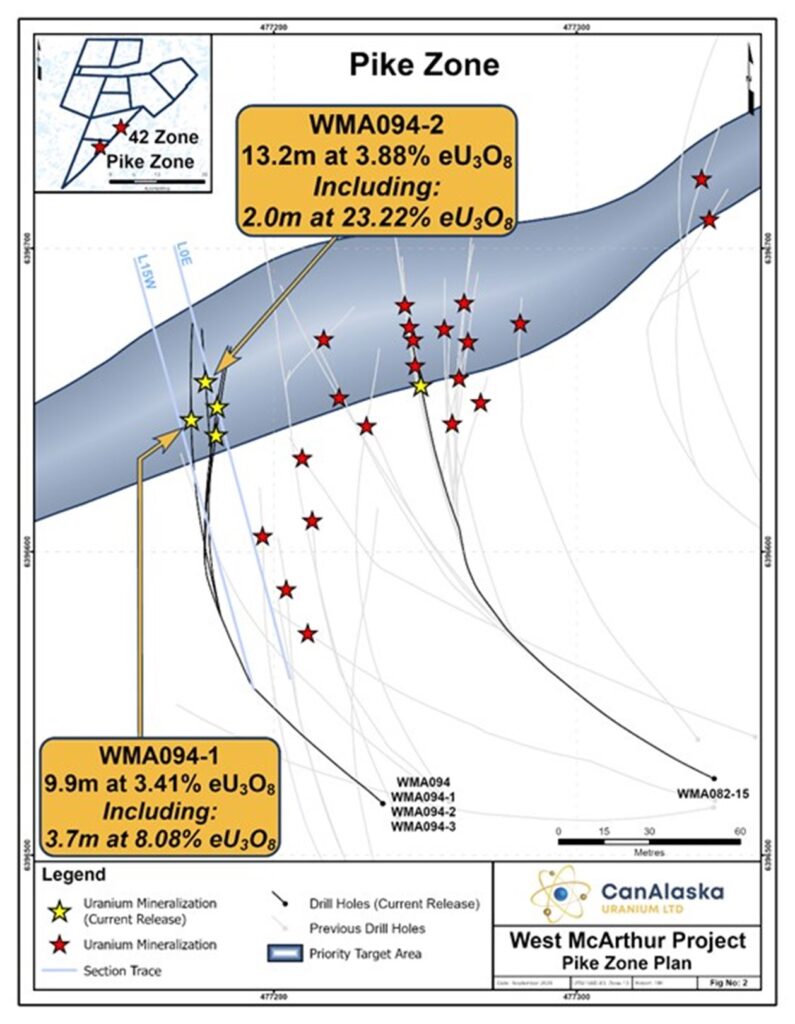
Figure 2 – West McArthur Pike Zone Plan
New Ultra High-Grade Uranium Discovered
The summer drill program on the West McArthur project is now complete. The program consisted of 15 unconformity tests split between Pike Zone expansion and extensional testing along the geophysical corridor.
At the Pike Zone, 12 unconformity tests were completed, 11 of which contained uranium mineralization. The results of the summer drill program indicate a strike length of uranium mineralization along the unconformity target area of approximately 200 metres that remains open in all directions.
Multiple drill fences within the unconformity target area define a high-grade core that remains open and extends over 100 metres in strike length. In addition, these results confirm that the Pike Zone remains open along strike to the west where the nearest drill hole is over 1 kilometre away.
Drillhole WMA094, completed along section L0, intersected the graphitic stratigraphy approximately 15 metres below the unconformity and contained multiple intervals of unconformity and basement-hosted uranium mineralization. WMA094 was completed approximately 100 metres up-dip along the graphitic stratigraphy from the first Pike Zone basement-hosted discovery hole (WMA067). Subsequent drilling along L0 and L15W intersected unconformity-associated uranium mineralization in WMA094-1, WMA094-2, and WMA094-3. Drillhole WMA094-2, which intersected high-grade unconformity uranium mineralization consisting of 3.88% eU3O8 over 13.2 metres, including ultra high-grade uranium mineralization of 23.22% eU3O8 over 2.0 metres, indicates the significant potential for additional ultra high-grade zones or pods within and beyond the currently established Pike Zone footprint.
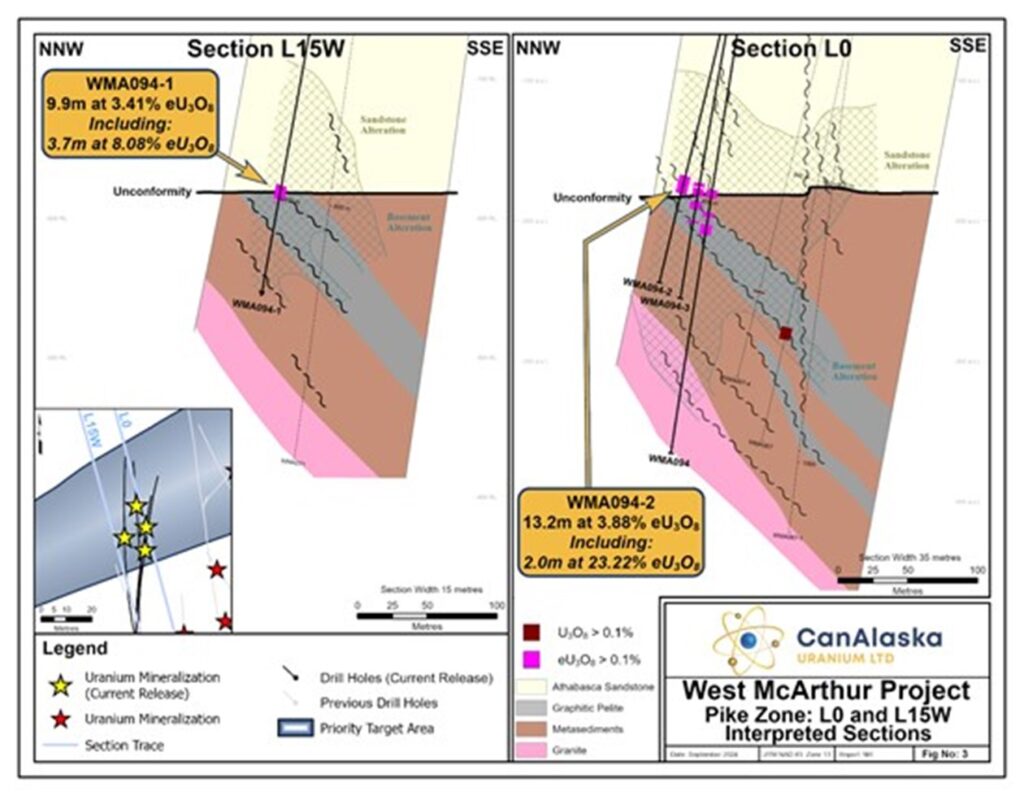
Figure 3 – Pike Zone L0 and L15W Sections
The Company completed one additional drillhole on L70E, WMA082-15, which tested down-dip of the ultra high-grade uranium mineralization reported in WMA082-7 (see News Release dated July 9th, 2024). WMA082-15 returned basement-hosted uranium mineralization along the controlling structures on L70E.
Table 1 – Radiometric Equivalent Uranium Grades
| DDH | From (m) |
To (m) |
Length (m)5 |
Average Grade (% eU3O8)6 |
| WMA0941,3 | 790.5 | 796.7 | 6.2 | 0.54 |
| Including4 | 794.3 | 794.8 | 0.5 | 3.21 |
| WMA0941,3 | 807.0 | 810.4 | 3.4 | 2.17 |
| Including4 | 807.7 | 810.0 | 2.3 | 2.95 |
| WMA0941,3 | 812.7 | 813.3 | 0.6 | 0.48 |
| WMA0941,3 | 815.6 | 823.2 | 7.6 | 0.35 |
| WMA094-11,3 | 790.7 | 800.6 | 9.9 | 3.41 |
| Including4 | 792.1 | 795.8 | 3.7 | 8.08 |
| Including4 | 796.8 | 797.2 | 0.4 | 3.09 |
| WMA094-11,3 | 803.2 | 803.6 | 0.4 | 0.2 |
| WMA094-21,3 | 784.7 | 797.9 | 13.2 | 3.88 |
| Including4 | 794.4 | 796.4 | 2.0 | 23.22 |
| WMA094-31,3 | 787.5 | 790.4 | 2.9 | 0.17 |
| WMA094-31,3 | 791.4 | 796.8 | 5.4 | 0.41 |
| WMA094-31,3 | 800.8 | 806.7 | 5.9 | 0.51 |
| WMA094-31,3 | 814.8 | 816.4 | 1.6 | 0.83 |
| WMA082-152,3 | 824.2 | 829.0 | 4.8 | 0.8 |
| Including4 | 828.4 | 828.7 | 0.3 | 2.89 |
| WMA082-152,3 | 835.7 | 836.3 | 0.6 | 0.31 |
|
||||
In addition, during the summer drill program, three drill holes were completed several kilometres along strike to the east of the Pike Zone on the geophysical target corridor. These drill holes were focused on testing geophysical gaps and structural targets identified from previous drill programs. Within WMA091 and WMA092, a broad sandstone structure characterized by strong silicification, clay alteration, and hydrothermal dravitic breccias was intersected. Within WMA093, a graphitic, chlorite altered fault zone was intersected approximately 90 metres into the basement. The results from the drill holes along strike to the east of the Pike Zone show encouraging post-Athabasca structural re-activation along the graphitic stratigraphy.
The Company is currently engaged in the budget process for the 2025 exploration program. Geochemical assay results from the summer portion of the 2024 exploration program are pending.
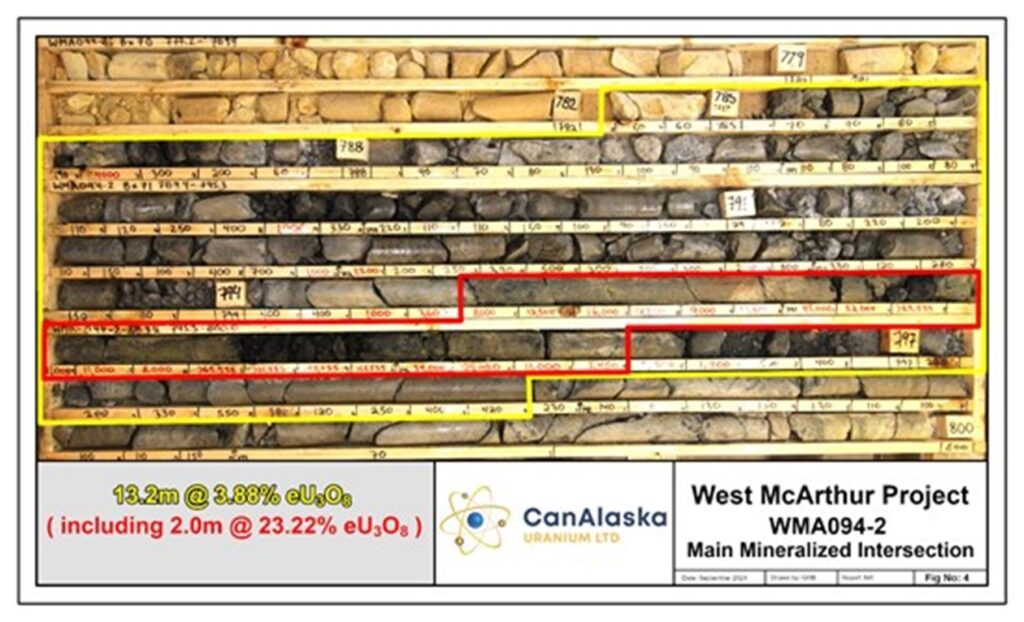
Figure 4 – WMA094-2 Core Photograph
Drillhole Details:
WMA094: The lower sandstone column of WMA094 is strongly bleached with limonite alteration extending over 80 metres above the unconformity. Within the lower sandstone column, multiple metre-scale fault zones were intersected and are characterized by broken to blocky core, broad hydrothermal dravitic breccias with localized re-activation, and zones of quartz dissolution. One interval of unconformity-associated uranium mineralization was intersected and is associated with strongly grey-altered sandstone (Figure 3; Table 1). The unconformity contact between the Athabasca sandstone and underlying basement rocks is interpreted to be at 793.9 metres down hole. Several intervals of basement-hosted uranium mineralization were intersected throughout the graphitic pelitic rocks (Figure 3; Table 1). These zones are characterized by structurally-controlled, disseminated, and foliation-controlled uranium mineralization. Within the mineralized intervals, isolated intervals of core loss were recorded due to intense alteration and quartz dissolution. The basement is strongly clay and chlorite altered as a broad halo around the basement-hosted uranium mineralization with multiple re-activated fault zones throughout the interval.
WMA094-1: The lower sandstone column of WMA094-1 is strongly bleached with limonite alteration extending over 90 metres above the unconformity. Within the lower sandstone column, multiple metre-scale fault zones were intersected and are characterized by broken to blocky core, large intervals of hydrothermal dravitic breccias with localized re-activation, and zones of quartz dissolution. Near the unconformity, the fault zones are associated with intense silicification and sooty pyrite alteration. WMA094-1 contains one main interval of unconformity-associated uranium mineralization characterized by massive to semi-massive, structurally-controlled, and disseminated mineralization associated with strong sooty pyrite, dark red hematite, and green-grey clay replacement immediately around the unconformity contact. (Figure 3; Table 1). Within the mineralized interval, isolated intervals of core loss were recorded due to intense alteration and quartz dissolution. The unconformity contact between the Athabasca sandstone and underlying basement rocks is interpreted to be at 795.1 metres down hole. The basement is strongly clay and chlorite altered as a broad halo around the high-grade uranium mineralization with multiple re-activated fault zones throughout the interval.
WMA094-2: The lower sandstone column of WMA094-2 is strongly bleached with limonite alteration extending over 90 metres above the unconformity. Within the lower sandstone column, multiple metre-scale fault zones were intersected and are characterized by broken to blocky core, large intervals of hydrothermal dravitic breccias with localized re-activation, and zones of quartz dissolution. Near the unconformity, the fault zones are associated with intense silicification and sooty pyrite alteration. WMA094-2 contains one main interval of unconformity-associated uranium mineralization characterized by massive to semi-massive, structurally-controlled, and disseminated mineralization associated with strong sooty pyrite, dark red hematite, and green-grey clay replacement immediately around the unconformity contact. (Figure 3; Figure 4; Table 1). Within the mineralized interval, isolated intervals of core loss were recorded due to intense alteration and quartz dissolution. The unconformity contact between the Athabasca sandstone and underlying basement rocks is interpreted to be at 799.8 metres down hole. The basement is strongly clay and chlorite altered as a broad halo around the high-grade uranium mineralization with multiple re-activated fault zones throughout the interval.
WMA094-3: The lower sandstone column of WMA094-3 is strongly bleached with limonite alteration extending over 80 metres above the unconformity. Within the lower sandstone column, multiple metre-scale fault zones were intersected and are characterized by broken to blocky core, large intervals of hydrothermal dravitic breccias with localized re-activation, and zones of quartz dissolution. Near the unconformity, the fault zones are associated with silicification and sooty pyrite alteration. WMA094-3 contains two intervals of unconformity-associated uranium mineralization characterized by structurally-controlled and disseminated mineralization associated with strong sooty pyrite, dark red hematite, and green-grey clay replacement immediately around the unconformity contact. (Figure 3; Table 1). Within the mineralized interval, isolated intervals of core loss were recorded due to intense alteration and quartz dissolution. The unconformity contact between the Athabasca sandstone and underlying basement rocks is interpreted to be at 794.6 metres down hole. Several intervals of basement-hosted uranium mineralization were intersected throughout the graphitic pelitic rocks (Figure 3; Table 1). These zones are characterized by semi-massive, structurally-controlled, and disseminated uranium mineralization. The basement is strongly clay and chlorite altered as a broad halo around the high-grade uranium mineralization with multiple re-activated fault zones throughout the interval.
WMA091 was completed 4.3 kilometres along strike to the east of the Pike Zone. Within the basal sandstone, from 580 – 630 metres, a large post-Athabasca fault zone was intersected. The fault zone is characterized by strong bleaching and silicification with multiple re-activated hydrothermal dravitic breccia zones.
WMA092 was completed 4.6 kilometres along strike to the east of the Pike Zone, following up the results from WMA091. In WMA092, a large post-Athabasca sandstone fault zone was intersected immediately at the unconformity, from 765 – 810 m, and was characterized by strong bleaching, limonite, silicification with multiple re-activated hydrothermal dravitic breccia zones.
WMA093 was completed 5.1 kilometres along strike to the east of the Pike Zone, following up the encouraging sandstone structures in WMA091 and WMA092. WMA093 intersected a 7 metre-wide post-Athabasca basement fault zone approximately 90 metres below the unconformity. The fault zone was hosted in a chlorite-altered graphitic pelite interval with intervals of clay gouge and breccia.
Other News
The Company will be presenting a webinar hosted by Red Cloud on October 2nd, 2024. Registration is available through the following link: https://redcloudfs.com/events/rcwebinar-cvv-4/
The Company invites you to view a special video tour of the West McArthur uranium project. This video provides an exclusive look at our key exploration activities and the exciting potential of the Pike Zone discovery. The video tour is available on the Company’s YouTube channel or through the following link: Inside West McArthur: Exploring High-Grade Uranium with CEO Cory Belyk and VP Nathan Bridge (youtube.com)
Geochemical Sampling Procedures and Use of Radiometric Equivalent Grades
All drill core samples from the program were shipped to the Saskatchewan Research Council Geoanalytical Laboratories (SRC) in Saskatoon, Saskatchewan in secure containment for preparation, processing, and multi-element analysis by ICP-MS and ICP-OES using total (HF:NHO3:HClO4) and partial digestion (HNO3:HCl), boron by fusion, and U3O8 wt% assay by ICP-OES using higher grade standards. Assay samples are chosen based on downhole probing radiometric equivalent uranium grades and scintillometer (SPP2 or CT007-M) peaks. Assay sample intervals comprise 0.3 – 0.8 metre continuous half-core split samples over the mineralized intervals. With all assay samples, one half of the split sample is retained and the other sent to the SRC for analysis. The SRC is an ISO/IEC 17025/2005 and Standards Council of Canada certified analytical laboratory. Blanks, standard reference materials, and repeats are inserted into the sample stream at regular intervals by CanAlaska and the SRC in accordance with CanAlaska’s quality assurance/quality control (QA/QC) procedures. Geochemical assay data are subject to verification procedures by qualified persons employed by CanAlaska prior to disclosure.
During active exploration programs drillholes are radiometrically logged using calibrated downhole GeoVista NGRS and TGGS (Triple GM) gamma probes which collect continuous readings along the length of the drillhole. Preliminary radiometric equivalent uranium grades (“eU3O8“) are then calculated from the downhole radiometric results. The probe is calibrated using an algorithm calculated from the calibration of the probe at the Saskatchewan Research Council facility in Saskatoon and from the comparison of probe results against geochemical analyses. At extremely high radiometric equivalent uranium grades, downhole gamma probes may become saturated, resulting in the probe being overwhelmed, which in turn can create difficulties in accurately determining extremely high-grade radiometric equivalent uranium grades, and a cap may be applied to the grade. The equivalent uranium grades are preliminary and are subsequently reported as definitive assay grades following sampling and chemical analysis of the mineralized drill core. In the case where core recovery within a mineralized intersection is poor or non-existent, radiometric grades are considered to be more representative of the mineralized intersection and may be reported in the place of assay grades. Radiometric equivalent probe results are subject to verification procedures by qualified persons employed by CanAlaska prior to disclosure.
All reported depths and intervals are drill hole depths and intervals, unless otherwise noted, and do not represent true thicknesses, which have yet to be determined.
About CanAlaska Uranium
CanAlaska Uranium Ltd. is a Canadian based exploration company and holds interest in approximately 500,000 hectares (1,235,000 acres) in Canada’s Athabasca Basin focused on exploration and discovery of high-grade unconformity uranium deposits. The Company is actively advancing the Pike Zone discovery – a new high-grade uranium discovery on its West McArthur Joint Venture project in the eastern Athabasca Basin. In addition, the Company has several other uranium-focused exploration programs. CanAlaska deploys a hybrid project generator model, focusing on the acquisition and sale of prospective projects, while also executing exploration programs on CanAlaska’s most strategic land holdings. The Company’s extensive portfolio has attracted international mining companies, including Cameco Corporation and Denison Mines as active partners. CanAlaska is led by an experienced team of professionals with a proven track record of discovery.
The Qualified Person under National Instrument 43-101 Standards of Disclosure for Mineral Projects for this news release is Nathan Bridge, MSc., P. Geo., Vice-President Exploration for CanAlaska Uranium Ltd., who has reviewed and approved its contents.
MORE or "UNCATEGORIZED"
Kuya Silver Confirms High-Grade Silver-Gold Vein Mineralization at Umm-Hadid with Initial Drill Results up to 1483.9 g/t AgEq over 2 Metres
Kuya Silver Corporation (CSE: KUYA) (OTCQB: KUYAF) (FSE: 6MR1) is... READ MORE
First Phosphate Closes Final Tranche of Oversubscribed Private Placement
First Phosphate Corp. (CSE: PHOS) (OTCQX: FRSPF) (FSE: KD0) is... READ MORE
GFG Receives Final Payment from the Sale of its Rattlesnake Hills Gold Project
GFG Resources Inc. (TSX-V: GFG) (OTCQB: GFGSF) announces that i... READ MORE
Goliath Receives $1,730,882 Through Warrant Exercises, Inclusive Of Crescat Capital A Longtime Strategic And Cornerstone Shareholder
Goliath Resources Limited (TSX-V: GOT) (OTCQB: GOTRF) (FSE: B4IF)... READ MORE
Robex Pours First Gold at Kiniéro on Schedule and Budget
Highlights: Gold bar weighing 2.64 kilograms (85 oz) poured in th... READ MORE












